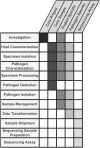Standardized metadata for human pathogen/vector genomic sequences
- PMID: 24936976
- PMCID: PMC4061050
- DOI: 10.1371/journal.pone.0099979
Standardized metadata for human pathogen/vector genomic sequences
Abstract
High throughput sequencing has accelerated the determination of genome sequences for thousands of human infectious disease pathogens and dozens of their vectors. The scale and scope of these data are enabling genotype-phenotype association studies to identify genetic determinants of pathogen virulence and drug/insecticide resistance, and phylogenetic studies to track the origin and spread of disease outbreaks. To maximize the utility of genomic sequences for these purposes, it is essential that metadata about the pathogen/vector isolate characteristics be collected and made available in organized, clear, and consistent formats. Here we report the development of the GSCID/BRC Project and Sample Application Standard, developed by representatives of the Genome Sequencing Centers for Infectious Diseases (GSCIDs), the Bioinformatics Resource Centers (BRCs) for Infectious Diseases, and the U.S. National Institute of Allergy and Infectious Diseases (NIAID), part of the National Institutes of Health (NIH), informed by interactions with numerous collaborating scientists. It includes mapping to terms from other data standards initiatives, including the Genomic Standards Consortium's minimal information (MIxS) and NCBI's BioSample/BioProjects checklists and the Ontology for Biomedical Investigations (OBI). The standard includes data fields about characteristics of the organism or environmental source of the specimen, spatial-temporal information about the specimen isolation event, phenotypic characteristics of the pathogen/vector isolated, and project leadership and support. By modeling metadata fields into an ontology-based semantic framework and reusing existing ontologies and minimum information checklists, the application standard can be extended to support additional project-specific data fields and integrated with other data represented with comparable standards. The use of this metadata standard by all ongoing and future GSCID sequencing projects will provide a consistent representation of these data in the BRC resources and other repositories that leverage these data, allowing investigators to identify relevant genomic sequences and perform comparative genomics analyses that are both statistically meaningful and biologically relevant.
Conflict of interest statement
Figures



References
Publication types
MeSH terms
Grants and funding
- HHSN272200900018C/AI/NIAID NIH HHS/United States
- HHSN272200900038C/AI/NIAID NIH HHS/United States
- U19 AI110820/AI/NIAID NIH HHS/United States
- HHSN272200900040C/AI/NIAID NIH HHS/United States
- R01GM093132/GM/NIGMS NIH HHS/United States
- ImNIH/Intramural NIH HHS/United States
- HHSN272200900039C/AI/NIAID NIH HHS/United States
- U19 AI110818/AI/NIAID NIH HHS/United States
- HHSN266200400041C/PHS HHS/United States
- HHSN272200900041C/AI/NIAID NIH HHS/United States
- R01 GM093132/GM/NIGMS NIH HHS/United States
- HHSN272200900007C/AI/NIAID NIH HHS/United States
- HHSN272200900009C/AI/NIAID NIH HHS/United States
LinkOut - more resources
Full Text Sources
Other Literature Sources

